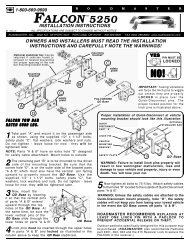tow bars - Roadmaster Inc.
tow bars - Roadmaster Inc.
tow bars - Roadmaster Inc.
You also want an ePaper? Increase the reach of your titles
YUMPU automatically turns print PDFs into web optimized ePapers that Google loves.
Sell sheet — anti-sway <strong>bars</strong><br />
What is ‘sway?’<br />
When you turn (or when crosswinds or passing<br />
18-wheelers rock the vehicle), the body of the vehicle<br />
rolls to one side. This side-to-side weight shift,<br />
which causes you to fight the steering wheel, is called<br />
“sway” (or, “body roll”).<br />
How does an anti-sway bar work?<br />
Anti-sway <strong>bars</strong> appear to be quite simple (a typical<br />
bar resembles an elongated “U”), but the physics<br />
behind their function is anything but simple — the<br />
bar is a torsional spring, which rotates on leverage<br />
arms in response to pressure shifts at either end of<br />
the axle. In this manner, force is displaced from one<br />
side of the vehicle to the other.<br />
In simple terms, an RSS anti-sway bar anchors the<br />
frame to the axle, so that the pressure shifts caused<br />
by crosswinds or cornering are virtually eliminated.<br />
What are the benefits?<br />
• Safety — body roll forces more weight to the<br />
outside tires, reducing traction. An anti-sway bar<br />
distributes the weight evenly over all four wheels.<br />
With more rubber on the road, the vehicle is more<br />
stable and responsive.<br />
Sway can force the driver into a series of oversteer<br />
reactions, especially during cornering. Compensating<br />
for sway at the steering wheel is dangerous at any<br />
speed.<br />
• Comfort — constantly having to correct for sway<br />
is not only dangerous, it’s also exhausting. (See ‘Why<br />
Fight It?’ on the other side.)<br />
RSS anti-sway <strong>bars</strong> virtually eliminate sway caused<br />
by crosswinds and weight shift. So even after hours<br />
at the wheel, the driver arrives fresh, instead of fatigued.<br />
How do I know if I need one?<br />
Every “yes” to the following questions is a “yes”<br />
for an RSS anti-sway bar:<br />
• Does the vehicle “roll” when cornering?<br />
• Do crosswinds or passing 18-wheelers rock the<br />
vehicle back and forth?<br />
• Does driving for an extended period of time leave<br />
you fatigued?<br />
• Is driving a “white knuckle” experience?<br />
How does it install?<br />
The bar is bolted on (usually, eight bolts) to the<br />
frame and the axle. On average, 60% require no<br />
drilling — the attachment bolts use existing hole patterns.<br />
Is there one for my vehicle?<br />
RSS anti-sway bar kits are available for motorhomes,<br />
trucks, vans, and SUVs. Each one is customdesigned<br />
specifically for your vehicle’s chassis.<br />
Towing and Suspension Solutions<br />
What if I have stock <strong>bars</strong>?<br />
Compared to stock <strong>bars</strong>, RSS anti-sway <strong>bars</strong> offer<br />
significantly more resistance to sway…<br />
• RSS anti-sway <strong>bars</strong> have a thicker diameter than<br />
stock <strong>bars</strong>. Often, a quarter to three-eights of an<br />
inch more. Every 1/8" increase in diameter results<br />
in a 30 percent increase in sway resistance.<br />
• RSS anti-sway <strong>bars</strong> are made from 4140 “chromoly”<br />
spring steel (a chrome and molybdenum alloy),<br />
which is considerably stronger and more durable<br />
than the standard carbon steel (a 1020 grade) used<br />
in many stock anti-sway <strong>bars</strong>.<br />
• Stock anti-sway bar bushings (the pivot points) are<br />
made of rubber, which hardens over time, making it<br />
more susceptible to abrasion. Rubber is also subject<br />
to corrosion, and additional wear, from petroleum<br />
products like gasoline or oil, and from ozone in the<br />
atmosphere.<br />
The more a stock bushing wears, the more the<br />
sway bar ‘gives.’ Over time, the vehicle leans farther<br />
and farther out of line, in response to the same load<br />
weights.<br />
RSS bushings are made of polyurethane, which is<br />
impervious to gas, oil and ozone corrosion, is more<br />
resistant to abrasion, and doesn’t buckle under<br />
heavier load weights.<br />
55





